Improved Dielectric Properties of Thermoplastic Polyurethane Elastomer Filled with Core–Shell Structured PDA@TiC Particles
Abstract
1. Introduction
2. Materials and Methods
2.1. Materials
2.2. Preparation of PDA@TiC and PDA@TiC/TPU Composites
2.3. Characterizations
3. Results and Discussions
3.1. FT-IR Analysis
3.2. Raman Analysis
3.3. Microstructure Analysis
3.4. TG Analysis
3.5. Dielectric Properties
4. Conclusions
Author Contributions
Funding
Conflicts of Interest
References
- Li, Y.; Fan, M.; Wu, K.; Yu, F.; Chai, S.; Chen, F.; Fu, Q. Polydopamine coating layer on graphene for suppressing loss tangent and enhancing dielectric constant of poly(vinylidene fluoride)/graphene composites. Compos. Part A Appl. S. 2015, 73, 859–862. [Google Scholar] [CrossRef]
- Jiang, L.; Betts, A.; Kennedy, D.; Jerrams, S. Improving the electromechanical performance of dielectric elastomers using silicone rubber and dopamine coated barium titanate. Mater. Des. 2015, 85, 7337–7342. [Google Scholar] [CrossRef]
- Gómez, J.; Recio, I.; Navas, A.; Villaro, E.; Galindo, B.; Ortega-Murguialday, A. Processing influence on dielectric, mechanical, and electrical properties of reduced graphene oxide-TPU nanocomposites. J. Appl. Polym. Sci. 2019, 136, 47220. [Google Scholar] [CrossRef]
- Yang, J.; Zhang, T.; Zhang, Y.; Zhang, N.; Huang, T.; Wang, Y. Constructing the “core-shell” structured island domain in polymer blends to achieve high dielectric constant and low loss. Polym. Int. 2020, 69, 228–238. [Google Scholar] [CrossRef]
- Barick, A.K.; Tripathy, D.K. Effect of nanofiber on material properties of vapor-grown carbon nanofiber reinforced thermoplastic polyurethane (TPU/CNF) nanocomposites prepared by melt compounding. Compos. Part A Appl. S. 2010, 41, 1471–1482. [Google Scholar] [CrossRef]
- Zhang, L.; Chen, S.; Yuan, S.; Wang, D. Low dielectric loss and weak frequency dependence of dielectric permittivity of the CeO2/polystyrene nanocomposite films. Appl. Phys. Lett. 2014, 105, 660. [Google Scholar] [CrossRef]
- Wang, Z.; Zhou, W.; Sui, X.; Dong, L.; Chen, Q.; Zuo, J.; Cai, H. Dynamic thermal-dielectric behavior of core-shell-structured aluminum particle-reinforced epoxy composites. High Perform. Polym. 2017, 29, 3–12. [Google Scholar] [CrossRef]
- Ke, K.; Mcmaster, M.; Christopherson, W.; Singer, K.; Manas-Zloczower, I. Effects of branched carbon nanotubes and graphene nanoplatelets on dielectric properties of thermoplastic polyurethane at different temperatures. Compos. Part B Eng. 2019, 166, 673–680. [Google Scholar] [CrossRef]
- Fan, B.H.; Zha, J.W.; Wang, D.R.; Zhao, J.; Dang, Z.M. Experimental study and theoretical prediction of dielectric permittivity in BaTiO3/polyimide nanocomposite films. Appl. Phys. Lett. 2012, 100, 092903. [Google Scholar] [CrossRef]
- Yuan, D.; Chen, M.; Xu, Y.; Huang, L.; Ma, J.; Peng, Q.; Cai, X. High-performance PA1/TPU films with enhanced dielectric constant and low loss tangent. J. Appl. Polym. Sci. 2020, 137, 48469. [Google Scholar] [CrossRef]
- Zheng, M.S.; Zha, J.W.; Yang, Y.; Han, P.; Hu, C.H.; Wen, Y.-Q.; Dang, Z.-M. Polyurethane induced high breakdown strength and high energy storage density in polyurethane/poly(vinylidene fluoride) composite films. Appl. Phys. Lett. 2017, 110, 252902. [Google Scholar] [CrossRef]
- Xiao, S.P.; Huang, H.X. In situ vitamin C reduction of graphene oxide for preparing flexible TPU nanocomposites with high dielectric permittivity and low didissipation factors. Polym. Test. 2018, 66, 334–341. [Google Scholar] [CrossRef]
- Chen, T.; Qiu, J.; Zhu, K.; He, X.; Kang, X.; Dong, E. Poly(methyl methacrylate)-functionalized graphene/polyurethane dielectric elastomer composites with superior electric field induced strain. Mater. Lett. 2014, 128, 19–22. [Google Scholar] [CrossRef]
- Kim, Y.K.; Kim, J.P.; Park, C.K.; Yun, S.J.; Kim, W.; Heu, S.; Park, J.-S. Electron-emission properties of titanium carbide-coated carbon nanotubes grown on a nano-sized tungsten tip. Thin Solid Films 2008, 517, 1156–1160. [Google Scholar] [CrossRef]
- Xie, Z.J.; Mai, Y.J.; Lian, W.Q.; He, S.L.; Jie, X.H. Titanium carbide coating with enhanced tribological properties obtained by EDC using partially sintered titanium electrodes and graphite powder mixed dielectric. Surf. Coat. Tech. 2016, 300, 50–57. [Google Scholar] [CrossRef]
- Wang, Y.; Luo, F.; Zhou, W.; Zhu, D. Dielectric and electromagnetic wave absorbing properties of TiC/epoxy composites in the GHz range. Ceram. Int. 2014, 40, 10749–10754. [Google Scholar] [CrossRef]
- Liu, S.; Wang, J.; Wang, J.; Shen, B.; Zhai, J.; Guo, C.; Zhou, J. Core-shell structured BaTiO3@SiO2, nanofibers for poly(vinylidene fluoride) nanocomposites with high discharged energy. Mater. Lett. 2016, 189, 176–179. [Google Scholar] [CrossRef]
- Yang, D.; Tian, M.; Wang, W.; Li, D.; Li, R.; Liu, H.; Zhang, L. Controllable dielectric and electrical performance of polymer composites with novel core/shell-structured conductive particles through biomimetic method. Electrochim. Acta 2013, 87, 9–17. [Google Scholar] [CrossRef]
- Dang, Z.M.; Yuan, J.K.; Yao, S.H.; Liao, R.J. Flexible nanodielectric materials with high permittivity for power energy storage. Adv. Mater. 2014, 25, 6334–6365. [Google Scholar] [CrossRef]
- Zhang, X.; Li, Z.; Yuan, X.; Cui, Z.; Yang, X. Fabrication of dopamine-modified hyaluronic acid/chitosan multilayers on titanium alloy by layer-by-layer self-assembly for promoting osteoblast growth. Appl. Surf. Sci. 2013, 284, 732–737. [Google Scholar] [CrossRef]
- Wan, X.; Zhan, Y.; Long, Z.; Zeng, G.; Ren, Y.; He, Y. High-performance magnetic poly (arylene ether nitrile) nanocomposites: Co-modification of Fe3O4, via mussel inspired poly(dopamine) and amino functionalized silane KH550. Appl. Surf. Sci. 2017, 425, 905–914. [Google Scholar] [CrossRef]
- Ren, P.; Wu, C.; Ponder, J.W. Polarizable atomic multipole-based molecular mechanics for organic molecules. J. Chem. Theory Comput. 2011, 7, 3143. [Google Scholar] [CrossRef] [PubMed]
- Zhang, L.; Yuan, S.; Chen, S.; Wang, D.; Han, B.Z.; Dang, Z.M. Preparation and dielectric properties of core–shell structured Ag@polydopamine/poly(vinylidene fluoride) composites. Compos. Sci. Technol. 2015, 110, 126–131. [Google Scholar] [CrossRef]
- Thakur, V.K.; Vennerberg, D.; Madbouly, S.A.; Kessler, M.R. Bio-inspired green surface functionalization of PMMA for multifunctional capacitors. Rsc. Adv. 2014, 4, 6677–6684. [Google Scholar] [CrossRef]
- Dai, Z.H.; Han, J.R.; Gao, Y.; Xu, J.; He, J.; Guo, B.H. Increased dielectric permittivity of poly(vinylidene fluoride-co-chlorotrifluoroethylene) nanocomposites by coating BaTiO3 with functional groups qwning high bond dipole moment. Colloids Surf. A 2017, 529, 560–570. [Google Scholar] [CrossRef]
- Fan, B.H.; Zha, J.W.; Wang, D.; Zhao, J.; Dang, Z.M. Size-dependent low-frequency dielectric properties in the BaTiO3/poly(vinylidene fluoride) nanocomposite films. Appl. Phys. Lett. 2012, 100, 012903. [Google Scholar] [CrossRef]
- Zeng, X.; Yu, S.; Sun, R.; Xu, J.B. Mechanical reinforcement while remaining electrical insulation of glass fibre/polymer composites using core–shell CNT@SiO2, hybrids as fillers. Compos. Part A Appl. S. 2015, 73, 260–268. [Google Scholar] [CrossRef]
- Liu, S.; Sun, H.; Ning, N.; Zhang, L.; Tian, M.; Zhu, W.; Chan, T.W. Aligned carbon nanotubes stabilized liquid phase exfoliated graphene hybrid and their polyurethane dielectric elastomers. Compos. Sci. Technol. 2016, 125, 30–37. [Google Scholar] [CrossRef]
- Kou, Y.; Zhou, W.; Xu, L.; Cai, H.; Wang, G.; Liu, X.; Chen, Q.; Dang, Z. Surface modification of GO by PDA for dielectric material with well-suppressed dielectric loss. High Perform. Polym. 2019, 31, 1183–1194. [Google Scholar] [CrossRef]
- Vasundhara, K.; Mandal, B.P.; Tyagi, A.K. Enhancement of dielectric permittivity and ferroelectricity of a modified cobalt nanoparticle and polyvinylidene fluoride-based composite. Rsc. Adv. 2015, 5, 8591–8597. [Google Scholar] [CrossRef]
- Liu, S.; Tian, M.; Yan, B.; Yang, Y.; Zhang, L.; Nishi, T.; Ning, N. High performance dielectric elastomers by partially reduced graphene oxide and disruption of hydrogen bonding of polyurethanes. Polymer 2015, 56, 375–384. [Google Scholar] [CrossRef]
- Fang, J.X.; Yin, Z.W. Dielectric Physics; Science Press: Beijing, China, 1989. [Google Scholar]
- Chen, M. Electronic Materials; Beijing University of Posts and Telecomunications Press: Beijing, China, 2006. [Google Scholar]
- Li, Y.; Yuan, J.; Xue, J.; Cai, F.; Chen, F.; Fu, Q. Towards suppressing loss tangent: Effect of polydopamine coating layers on dielectric properties of core-shell barium titanate filled polyvinylidene fluoride composites. Compos. Sci. Technol. 2015, 118, 198–206. [Google Scholar] [CrossRef]
- Ning, N.; Li, S.; Sun, H.; Wang, Y.; Liu, S.; Yao, Y.; Yan, B.; Zhang, L.; Tian, M. Largely improved electromechanical properties of thermoplastic polyurethane dielectric elastomers by the synergistic effect of polyethylene glycol and partially reduced graphene oxide. Compos. Sci. Technol. 2017, 142, 311–320. [Google Scholar] [CrossRef]
- Zhou, W.; Zuo, J.; Ren, W. Thermal conductivity and dielectric properties of Al/PVDF composites. Compos. Part A Appl. S. 2015, 71, 184–191. [Google Scholar] [CrossRef]
- Li, Z.; Liu, F.; Yang, G.; Li, H.; Dong, L.; Xiong, C.; Wang, Q. Enhanced energy storage performance of ferroelectric polymer nanocomposites at relatively low electric fields induced by surface modified BaTiO3 nanofibers. Compos. Sci. Technol. 2018, 164, 214–221. [Google Scholar] [CrossRef]
- Pan, Z.; Yao, L.; Zhai, J.; Shen, B.; Wang, H. Significantly improved dielectric properties and energy density of polymer nanocomposites via small loaded of BaTiO3 nanotubes. Compos. Sci. Technol. 2017, 147, 30–38. [Google Scholar] [CrossRef]
- Dong, L.; Zhou, W.; Sui, X.; Wang, Z.; Cai, H.; Wu, P.; Zuo, J.; Liu, X. A carboxyl-terminated polybutadiene liquid rubber modified epoxy resin with enhanced toughness and excellent electrical properties. J. Electron. Mater. 2016, 45, 3776–3785. [Google Scholar] [CrossRef]
- Liu, T.; Huang, R.; Qi, X.; Dong, P.; Fu, Q. Facile preparation of rapidly electro-active shape memory thermoplastic polyurethane/polylactide blends via phase morphology control and incorporation of conductive fillers. Polymer 2017, 114, 28–35. [Google Scholar] [CrossRef]
- Wan, W.; Luo, J.; Huang, C.E.; Yang, J.; Feng, Y.; Yuan, W.X.; Ouyang, Y.; Chen, D.; Qiu, T. Calcium copper titanate/polyurethane composite films with high dielectric constant, low dielectric loss and super flexibility. Ceram. Int. 2018, 44, 5086–5092. [Google Scholar] [CrossRef]
- Fu, S.Y.; Feng, X.Q.; Lauke, B.; Mai, Y.W. Effects of particle size, particle/matrix interface adhesion and particle loading on mechanical properties of particulate–polymer composites. Compos. Part B Eng. 2008, 39, 933–961. [Google Scholar] [CrossRef]
- Hu, P.; Song, Y.; Liu, H.; Shen, Y.; Lin, Y.; Nan, C.W. Largely enhanced energy density in flexible P(VDF-TrFE) nanocomposites by surface-modified electrospun basrtio3 fibers. J. Mater. Chem. A 2013, 1, 1688–1693. [Google Scholar] [CrossRef]
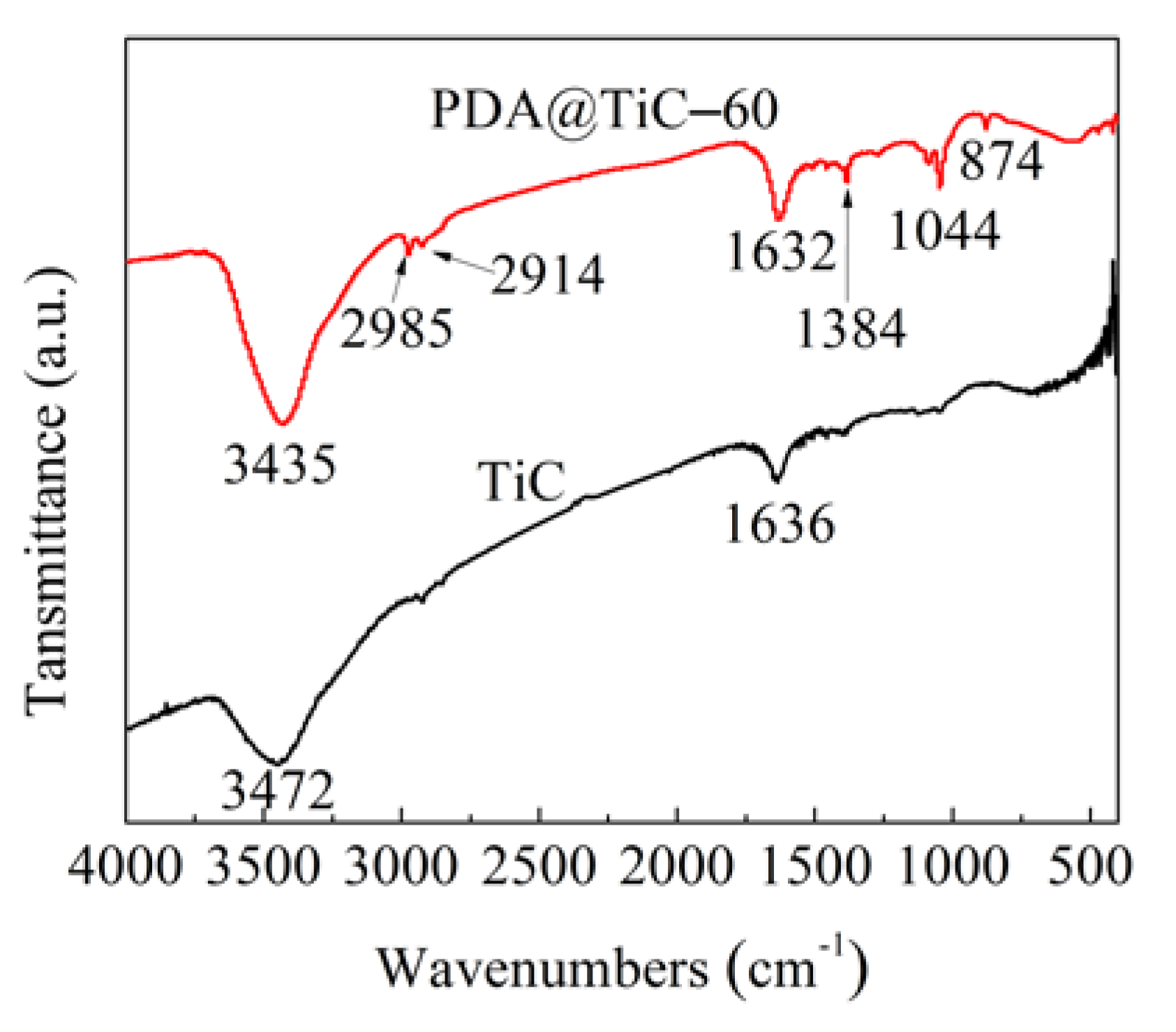
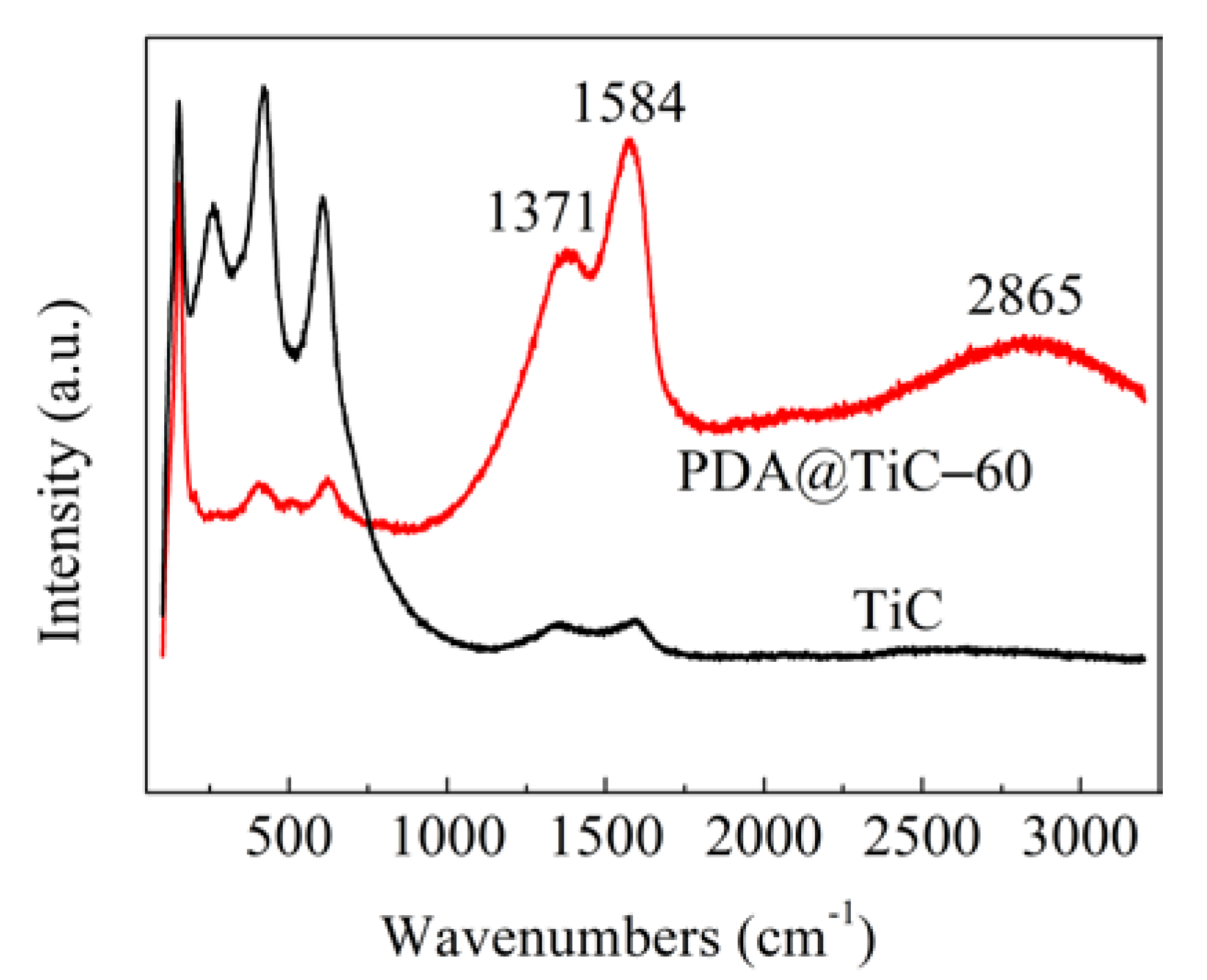
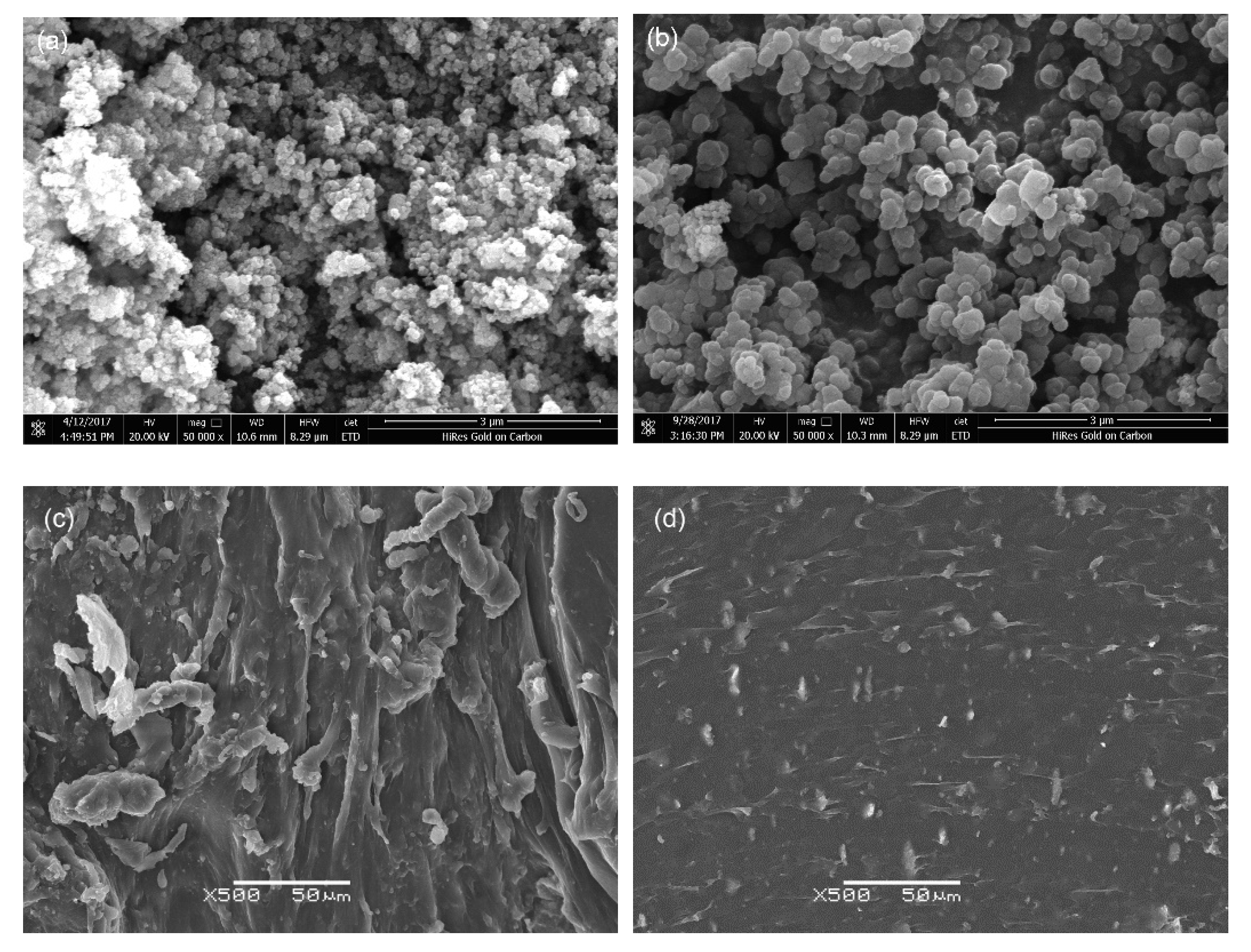
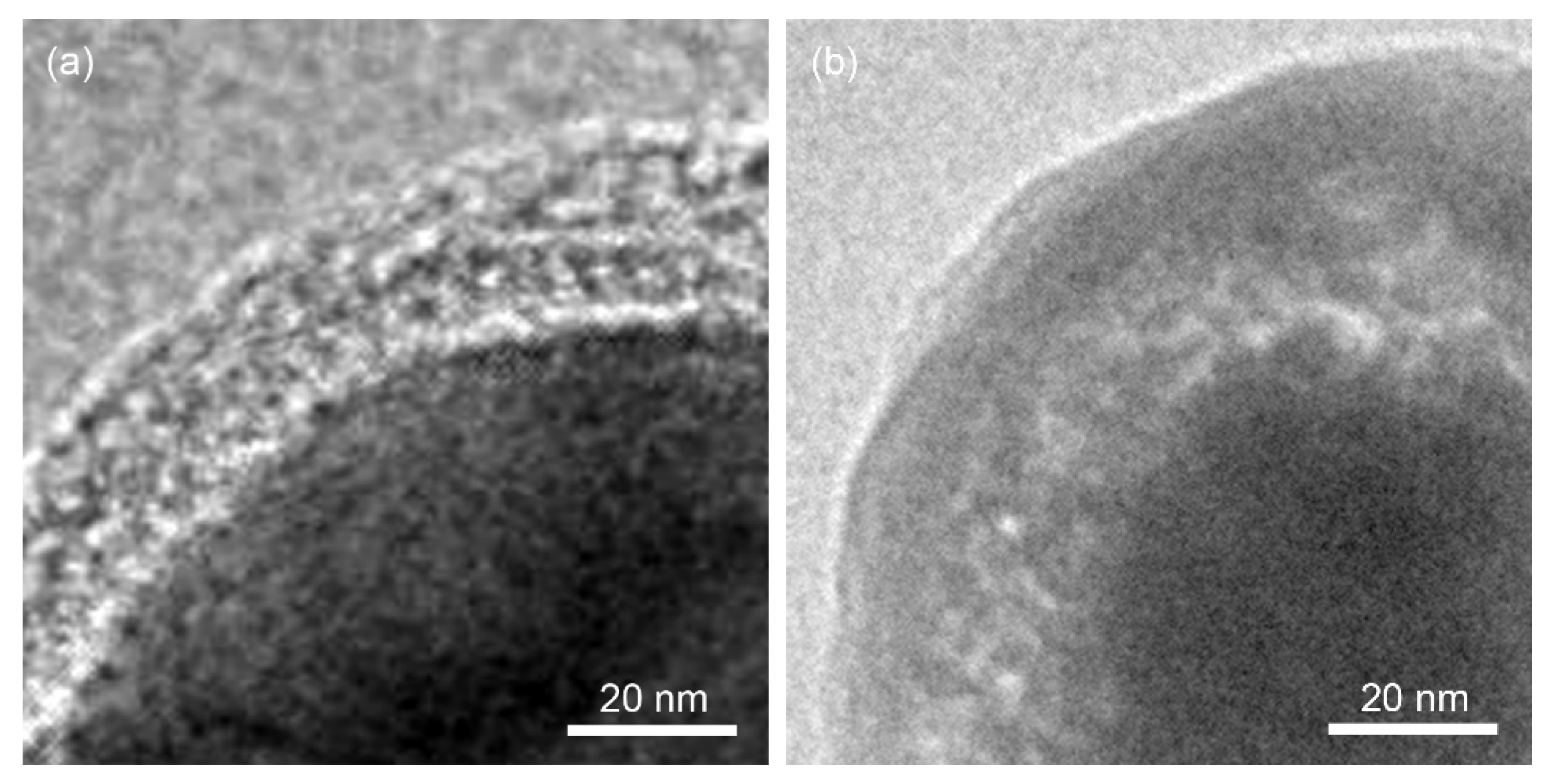
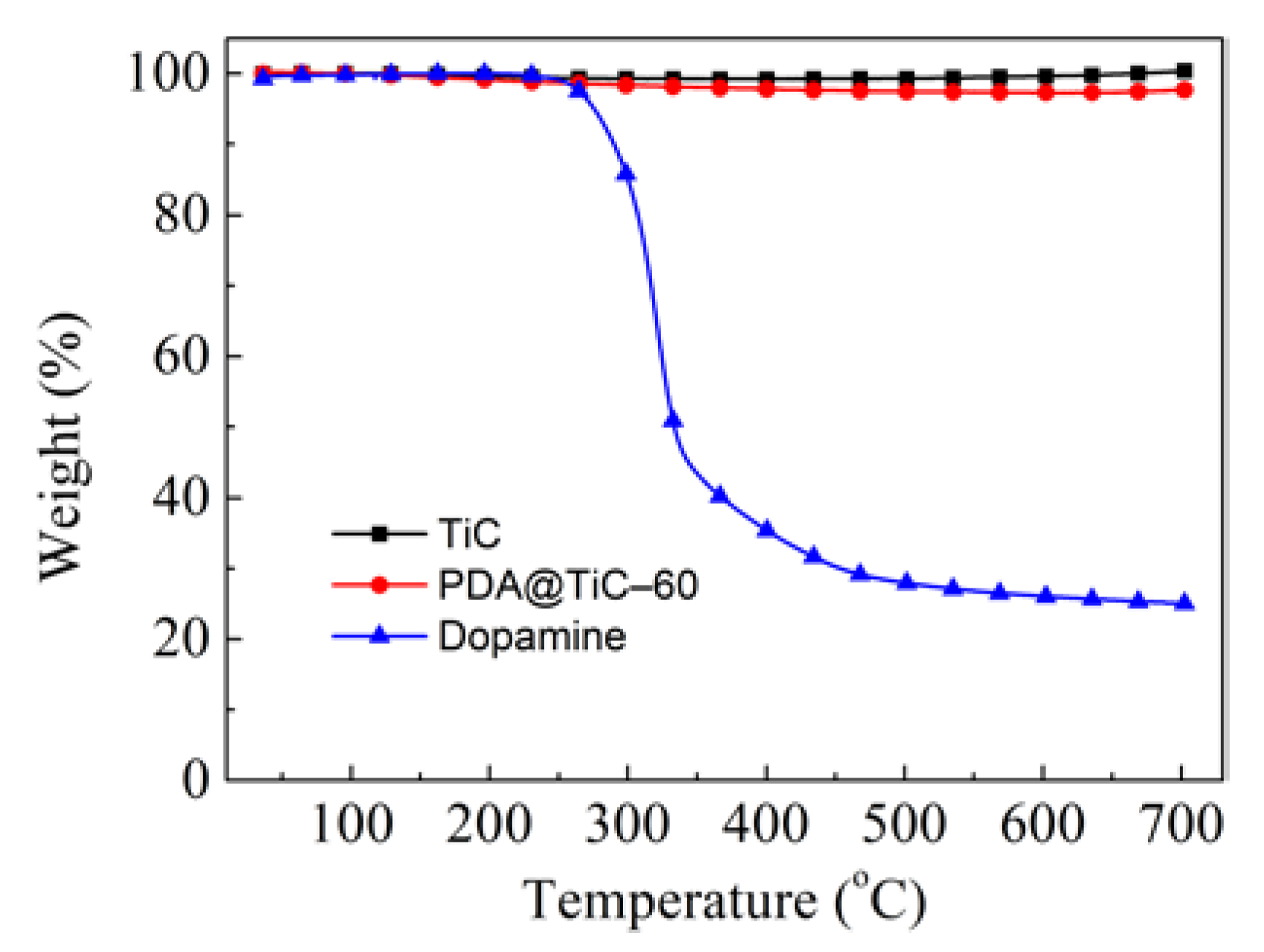
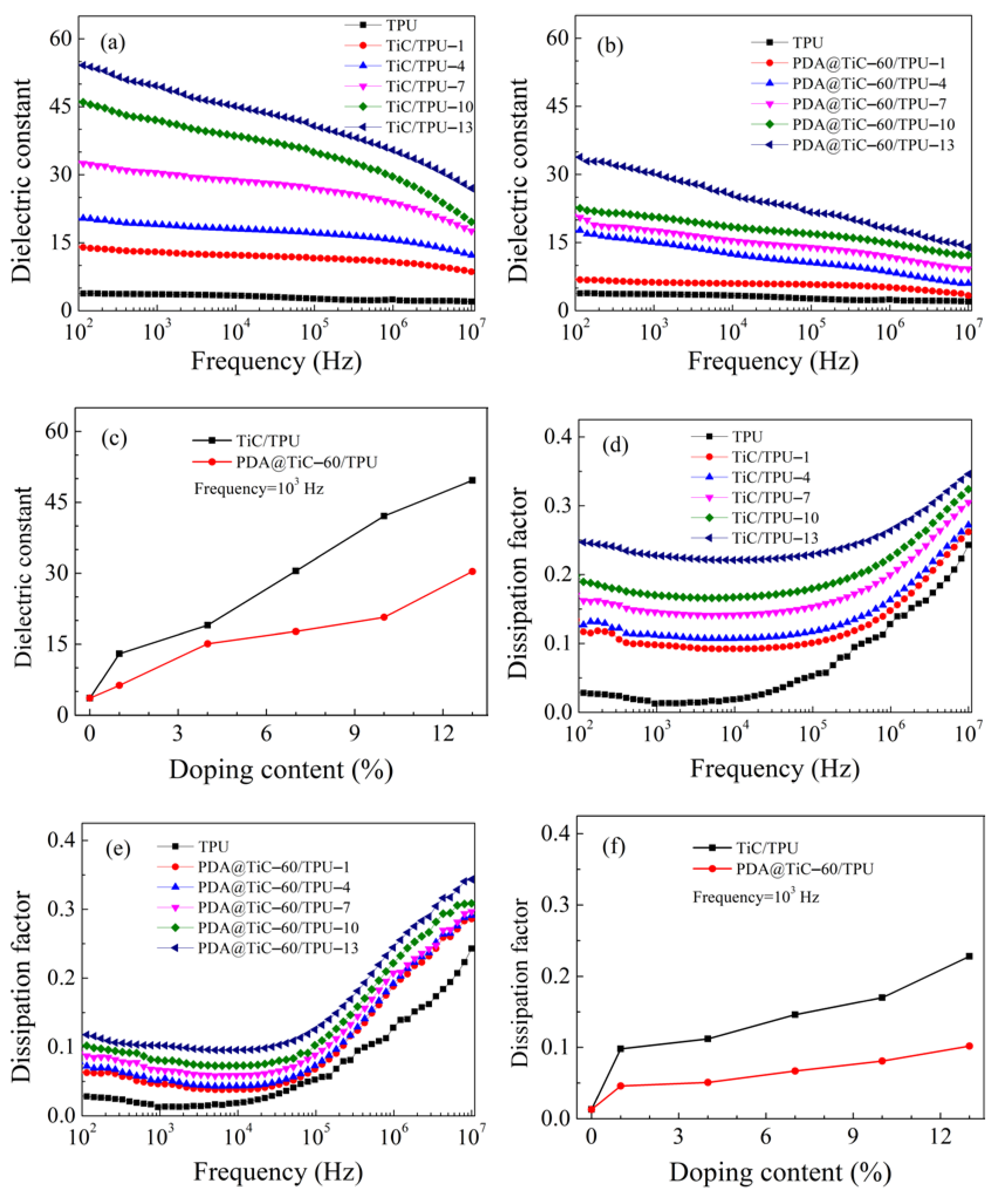
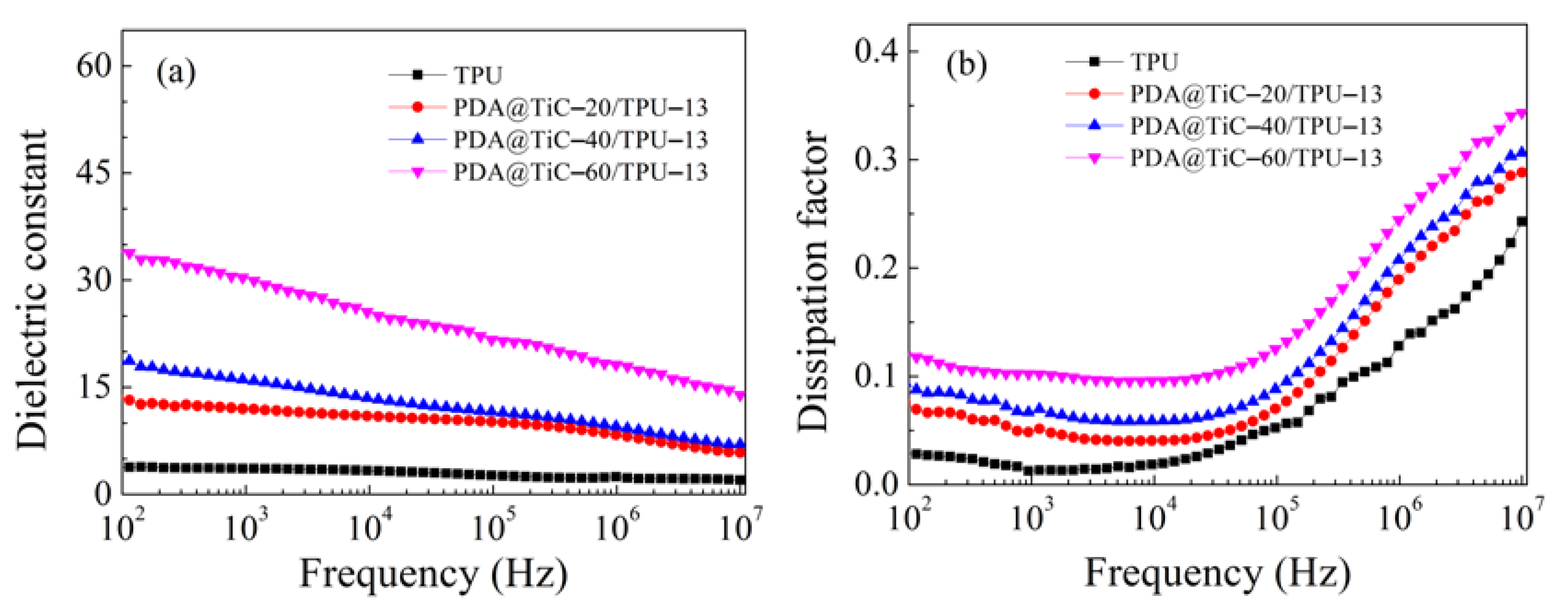
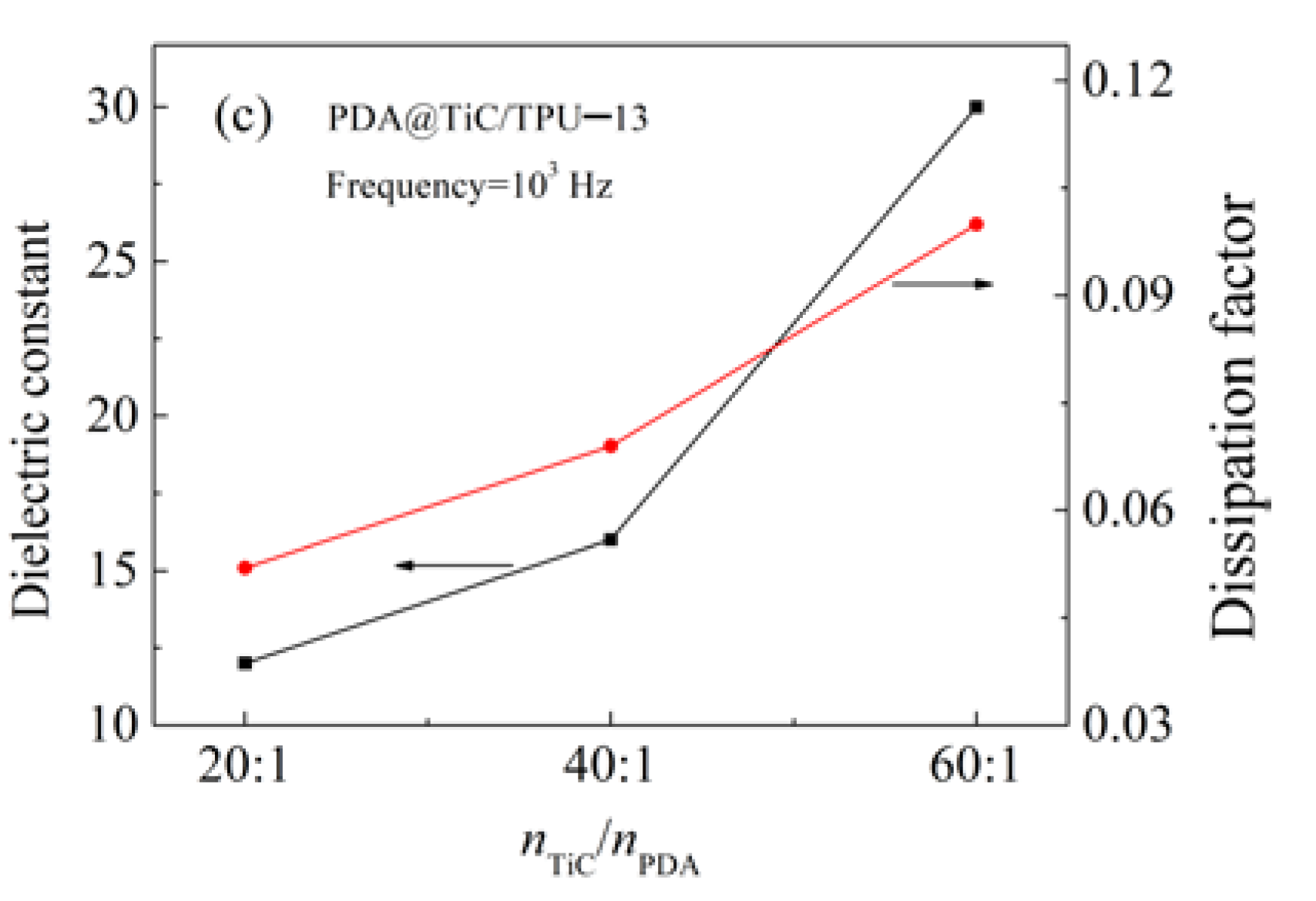
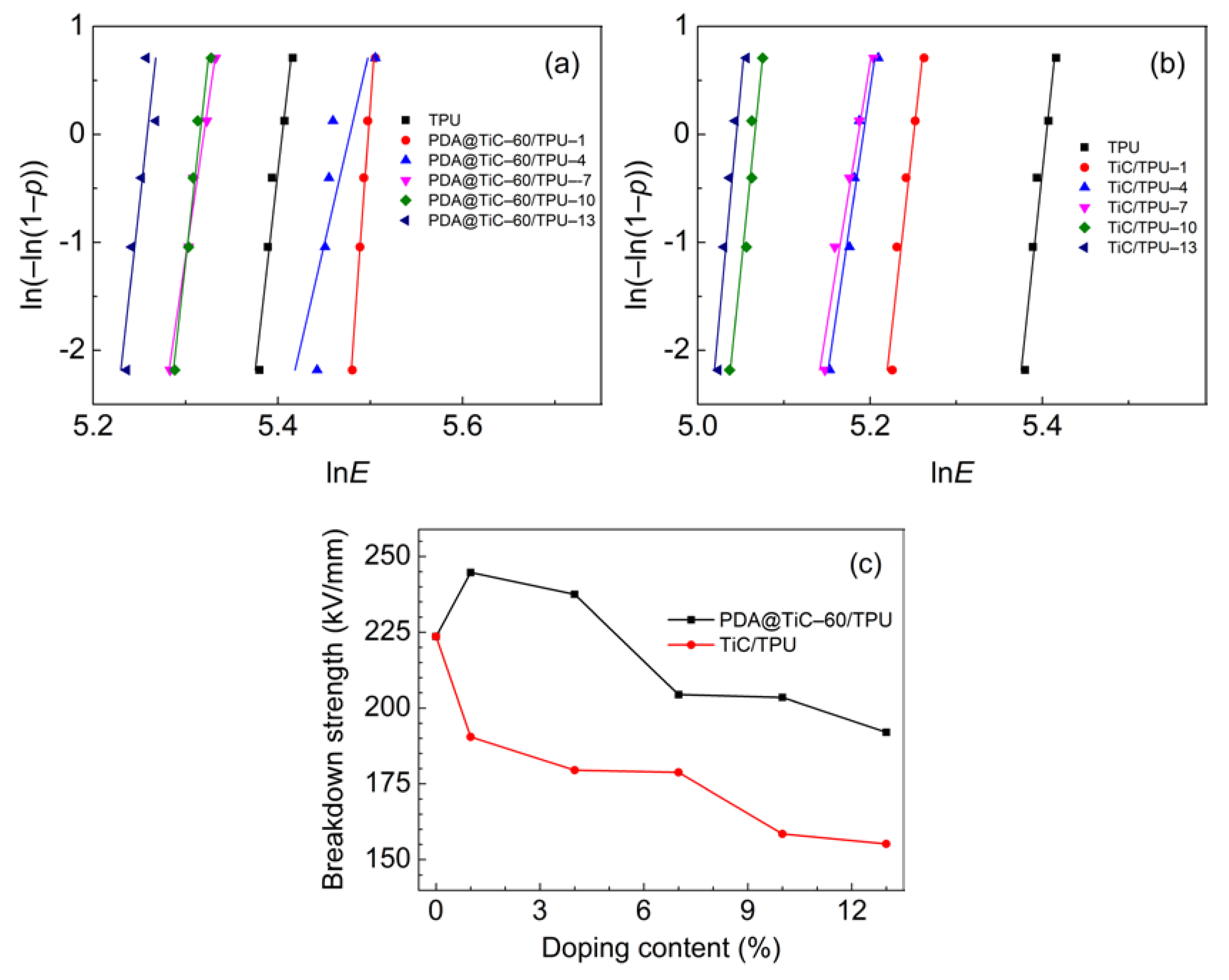
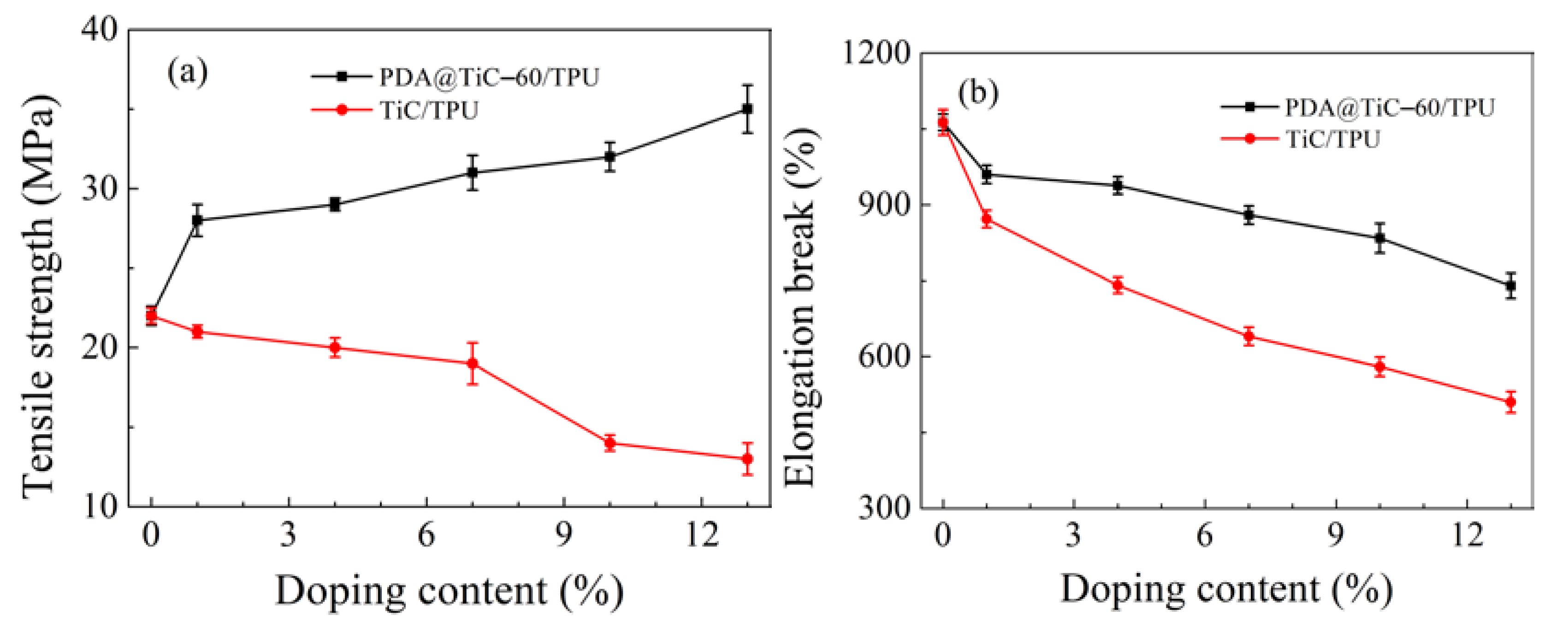
| Ample | Element Content/wt % | Atomic Ratio/% | ||||||
|---|---|---|---|---|---|---|---|---|
| C | O | N | Ti | C | O | N | Ti | |
| TiC | 36.53 ± 3.42 | 6.93 ± 0.30 | 0 | 56.54 ± 3.72 | 65.22 ± 2.99 | 9.31 ± 0.05 | 0 | 25.47 ± 2.94 |
| PDA@TiC−60 | 26.37 ± 0.87 | 8.87 ± 1.02 | 1.50 ± 0.02 | 63.26 ± 0.14 | 50.73 ± 3.37 | 16.30 ± 4.60 | 2.47 ± 0.12 | 30.50 ± 1.10 |
© 2020 by the authors. Licensee MDPI, Basel, Switzerland. This article is an open access article distributed under the terms and conditions of the Creative Commons Attribution (CC BY) license (http://creativecommons.org/licenses/by/4.0/).
Share and Cite
He, X.; Zhou, J.; Jin, L.; Long, X.; Wu, H.; Xu, L.; Gong, Y.; Zhou, W. Improved Dielectric Properties of Thermoplastic Polyurethane Elastomer Filled with Core–Shell Structured PDA@TiC Particles. Materials 2020, 13, 3341. https://doi.org/10.3390/ma13153341
He X, Zhou J, Jin L, Long X, Wu H, Xu L, Gong Y, Zhou W. Improved Dielectric Properties of Thermoplastic Polyurethane Elastomer Filled with Core–Shell Structured PDA@TiC Particles. Materials. 2020; 13(15):3341. https://doi.org/10.3390/ma13153341
Chicago/Turabian StyleHe, Xinfu, Jun Zhou, Liuyan Jin, Xueying Long, Hongju Wu, Li Xu, Ying Gong, and Wenying Zhou. 2020. "Improved Dielectric Properties of Thermoplastic Polyurethane Elastomer Filled with Core–Shell Structured PDA@TiC Particles" Materials 13, no. 15: 3341. https://doi.org/10.3390/ma13153341
APA StyleHe, X., Zhou, J., Jin, L., Long, X., Wu, H., Xu, L., Gong, Y., & Zhou, W. (2020). Improved Dielectric Properties of Thermoplastic Polyurethane Elastomer Filled with Core–Shell Structured PDA@TiC Particles. Materials, 13(15), 3341. https://doi.org/10.3390/ma13153341




